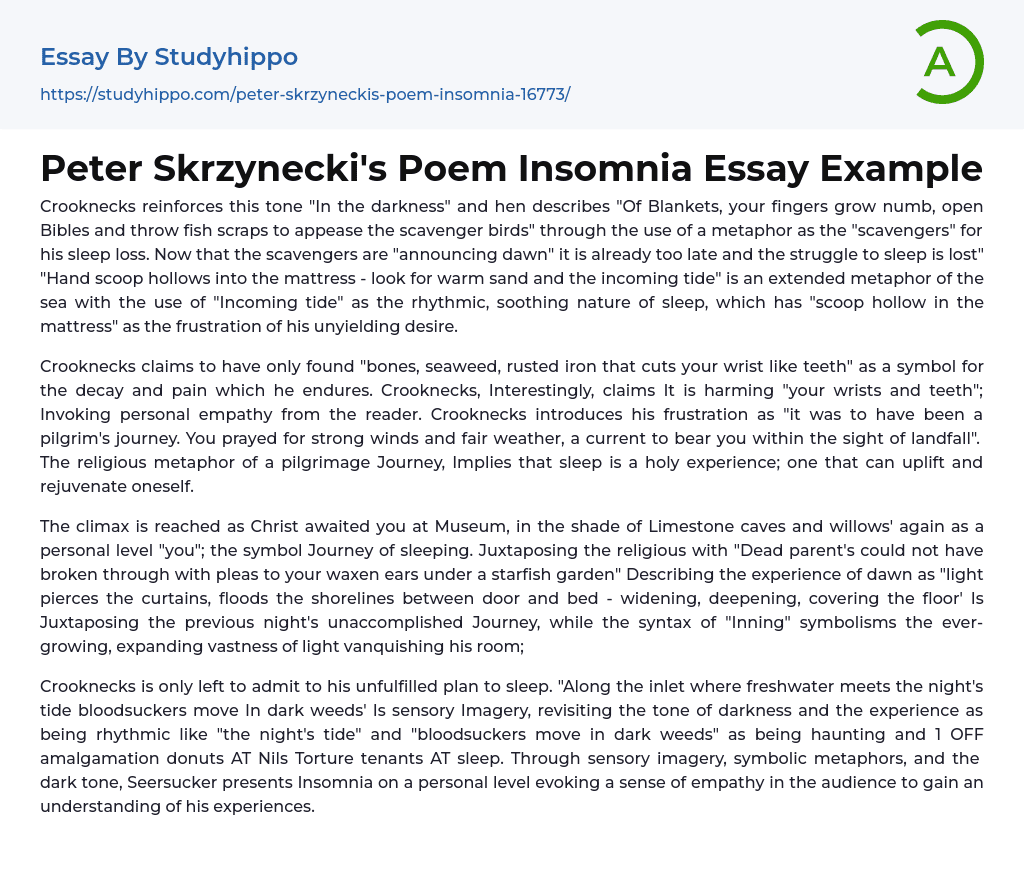In the text, Crooknecks conveys a certain tone by highlighting the darkness and the numbing sensations experienced with open Bibles and throwing fish scraps. Using the metaphor of scavenger birds, the author equates them to his sleep deprivation. The author emphasizes that it is already too late as the scavengers are now announcing dawn, indicating the lost battle to attain sleep. Furthermore, the phrase "Hand scoop hollows into the mattress - look for warm sand and the incoming tide" serves as an extended metaphor of the sea. Here, "Incoming tide" symbolizes the rhythmic and soothing nature of sleep, while the frustration of his unyielding desire is depicted through "scoop hollow in the mattress."
Crooknecks describes the items he finds, including "bones, seaweed, rusted iron that cuts your wrist like teeth," as symbolic of the deca
...y and pain he endures. Interestingly, he emphasizes that these objects harm "your wrists and teeth," thereby invoking personal empathy from the reader. Furthermore, Crooknecks expresses his frustration by stating that his journey was supposed to be a pilgrimage. He had hoped for "strong winds and fair weather, a current to bear [him] within the sight of landfall." This religious metaphor suggests that sleep is a holy experience capable of uplifting and rejuvenating oneself.
The climax is reached as Christ awaited you at the museum, in the shade of limestone caves and willows once more as a personal level symbolizing your journey of sleeping. Contrasting the religious aspect with the inability of dead parents to reach you through pleas to your waxen ears under a starfish garden. The experience of dawn is described as the light piercing the curtains, floodin
the shorelines between door and bed – widening, deepening, and covering the floor. This juxtaposes the previous night's unaccomplished journey, while the syntax of "inning" symbolizes the ever-growing, expanding vastness of light conquering his room.
Crooknecks openly acknowledges his unfulfilled desire to sleep. He describes how "bloodsuckers move in dark weeds" along the inlet where freshwater meets the night's tide, using sensory imagery to convey darkness and rhythmic experience. This haunting amalgamation torments Crooknecks, as he yearns for sleep. Seersucker effectively presents Insomnia on a personal level through the use of sensory imagery, symbolic metaphors, and a dark tone, ultimately evoking empathy in the audience and allowing them to comprehend his experiences.
- Canterbury Tales essays
- Dulce Et Decorum Est essays
- My Last Duchess essays
- Beowulf essays
- Sir Gawain And The Green Knight essays
- The Road essays
- Aeneid essays
- Odyssey essays
- Blackberry Picking essays
- Beowulf Epic Hero essays
- Common sense essays
- American Literature essays
- Between The World and Me essays
- Book Report essays
- Book Review essays
- Book Summary essays
- Books essays
- Character essays
- Coming of Age essays
- Dante's Inferno essays
- Everyday Use essays
- Flowers for Algernon essays
- Genre essays
- Greek Mythology essays
- Incidents in The Life of a Slave Girl essays
- Letter essays
- Literary Criticism essays
- Literary devices essays
- Literature Review essays
- Metaphor essays
- Myth essays
- Play essays
- Plot essays
- Poem essays
- Poetry Analysis essays
- Protagonist essays
- Reader essays
- Reason essays
- Rhetoric essays
- Rhetorical Question essays
- Rhyme essays
- Simile essays
- Tragic Hero essays
- Translation essays
- Understanding essays
- Utopia essays
- Villain essays
- Writer essays
- Aldous Huxley essays
- Alice Walker essays




